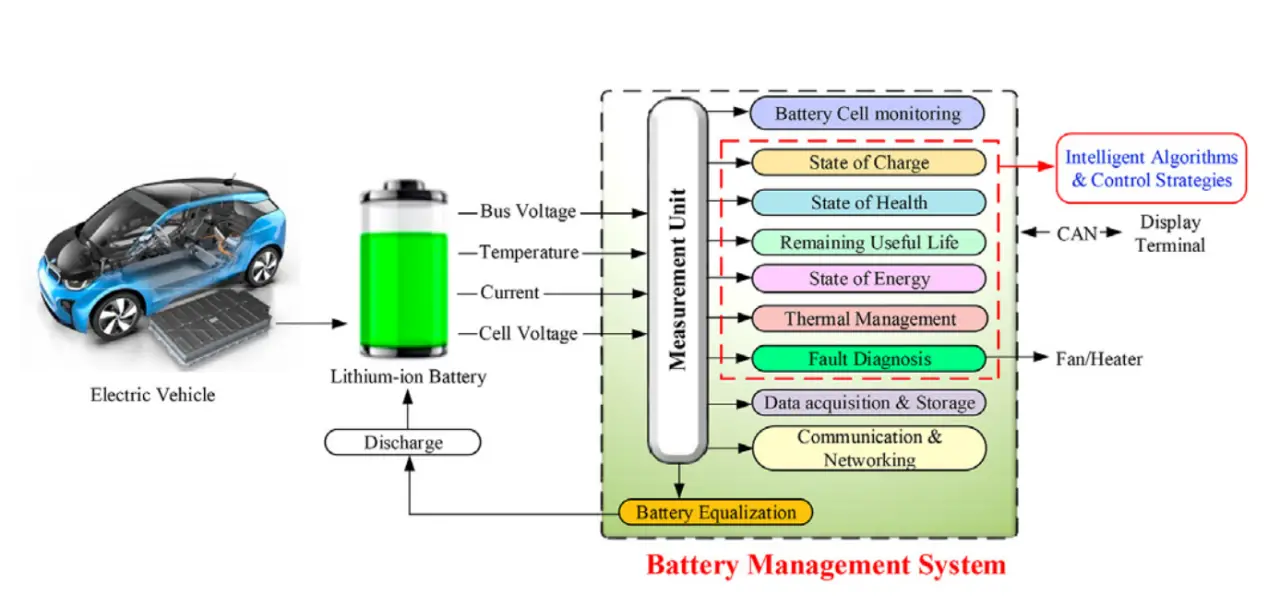The demand for EVs is at an all-time high now. Since EVs don’t have any engine or drive train, it becomes more important to implement a smart management system to control how a battery should behave as the battery is the heart of an electric vehicle.
Since the battery and the motor are the key components of an electric vehicle, things get smoother to control their operation at the component level. That is where the Battery Management System in electric vehicles comes into the picture. Let’s learn more about it in this article.
What Is A Battery Electric Vehicle?
A battery-electric vehicle or all-electric vehicle uses a motor to propel the wheels. The motors get the power from a battery. There is no internal combustion engine or any drive train in electric vehicles.
The chemical energy is converted into mechanical energy in electric vehicles. Batteries are used to store the energy and transfer it to the motor when there is a need.
Depending on the requirements, different sizes, different types, and different capacity batteries are used. Lithium Ion batteries are most common in electric vehicles due to their high energy density (100-265wh/kg). You can construct a high-capacity battery pack in a limited space. Due to its compact size, it is most suitable for electric vehicles.
But that opens the loopholes to safety. Due to their compact size and high energy density, lithium-ion battery packs are notorious for heat and fire hazards. A smart battery management system is essential to run electric vehicles under safety limits.
Battery Management System In Electric Vehicles
Battery Management System ( BMS ) manages the electronics of a cell or a battery pack so that it can work under safe operational parameters. It ensures that both the battery and the user are working under safe limits.
It can monitor the State Of Health (SoH) data of the battery and accordingly adjusts different parameters to ensure that the battery is working under a safe voltage limit and there are no thermal or fire hazards. The BMS system also ensures that the battery is healthy for a long time by controlling its operational usage and cell balancing.
BMS is also responsible for charging control, overcharge protection, overheating protection, and short circuit protection. BMS can also hook up with external sensors to give real-time data on State Of Charge, Range, and Voltage.

Key Functions Of Battery Management System
The Battery Management System does a plethora of jobs apart from the safety of the battery which is its primary job. Here are some of the key functions of BMS
Monitor Battery Parameters
Monitoring battery parameters is one of the primary jobs that BMS does. Here are some of the parameters that BMS monitors. Remember, these are just key parameters. A BMS can show other relevant data too based on how it is programmed.
- Voltage: Shows the battery pack’s combined voltage and maximum and minimum voltage attained by the battery pack
- Temperature: This shows the average cell temperature, coolant intake and output temperatures, and the overall battery temperature.
- State Of Charge (SOC): It is the charging level indicator that shows on the instrument panel
- State Of Health (SOH): Shows the overall health of the battery. SOH decreases over some time
- State Of Safety (SOS): Shows an indication if something is wrong with the battery. It could be a warning or error.
- State Of Power (SOP): Shows the average cell temperature, coolant intake, and output temperatures, and the overall battery temperature.
Making Key Calculations
Yes, BMS can also do some key calculations and display the data that can tell how the battery is operating, at what capacity it is capacity, how is the efficiency, and other relevant data.
- Energy: It shows the delivered energy in kWh since the last charge
- Impedance: Shows the internal state of health of battery cells
- Charge in Ampere per hour (Ah): Shows the charge in Ampere per hour (Ah) delivered or contained in a cell, to determine the cell’s efficiency
- The total number of charge cycles that the battery has gone through
Thermal Management
Heat is the main enemy of batteries. Due to the compactness of Lithium-ion batteries and the way cells are contained in the battery pack, it is very fragile to temperature differences. Due to this battery management system does a lot of work to keep the battery temperature in control.
For example, when an electric vehicle runs at a very high speed, it consumes a lot of energy and thus increases the temperature of the battery pack. To control the temperature, the battery management system can automatically reduce the speed or even turn off the vehicle.
All vehicle has a passive thermal management system. It is either done by using an air-cooled system or a liquid-cooled system. But when you use this passive thermal management system, the battery capacity degrades because the battery consumes a significant amount of energy to run these systems.
The BMS can also manage when and how that coolant should flow and how those should flow. Ultimately, it is the BMS that decides what to do to keep the battery temperature in control.
Optimize Battery Utilization
One of the key jobs that a BMS does is to optimize the battery charge so that the vehicle gets the maximum range per charge without compromising on the required power. That is why electrical vehicles have different modes. Different modes will consume different amounts of battery charge and also will deliver different levels of power.
Conclusion: Battery Management System In Electric Vehicles
Battery Management System is a key component in electric vehicles. It is the brain of the vehicle that decides how to use the battery efficiently without compromising on the power and safety of the battery pack. It can monitor and control most of the vehicle parameters to ensure the safety of the battery and the user.